The History of Genetic Modification Part 2: Reverse Engineering
Hey guys make note of the extensively researched references list at the bottom, I tried diligently to find a scientific publication when possible, TONS of information available!
The "Race to Crack The Code" of the previous century vastly increased scientific understanding of DNA and RNA and laid the framework that paved the way for the sciences of genetics, biotechnology, biochemistry and molecular biology, opening doors many wished left locked and bolted.
Now for the Good Stuff
Disclaimer: When I say the good stuff, I do not imply that I support genetic modification in anyway. This is where scientists begin to take the last century of research into biological framework and begin to actually explore the possibilities of altering it's properties and as scary as the potentiality is, you've got to admit it's pretty interesting...

Paul Berg 1972 (center)
GMO Timeline
1946
Joshua Lederburg in collaboration with Edward Tatum combined their research on bacterial genetics. Working together over the course of a year experimenting on E. Coli strains they discovered that bacteria undergo a life stage in which they mate and exchange genes, demonstrating that the offspring also have distinct genetic material and increasing understanding of the way bacteria evolve.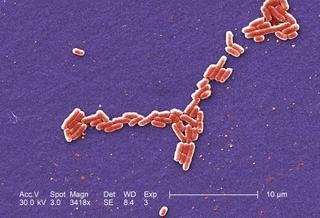
Esherichia Coli, colorized 3814x magnification
1960
Marshall Nirenberg and J. Heinrich Matthaei created a synthetic RNA molecule an introduced into the cell of an E. Coli bacterium, their findings proved that messenger RNA directs protein synthesis1969
John E. Franz discovers Glyphosate an herbicide non toxic to animals.1972
Paul Berg published his"Biochemical Method for Inserting New Genetic Information into DNA..." a culmination of decades long research on DNA-RNA transcription and later gene regulation. The paper describes Berg's method for splicing DNA molecules of the SV40(simian virus 40) and the lambda virus, this resulted in the creation of the first recombinant DNA molecule(rDNA) and is the beginning of rDNA technology.1973
Concerned about possible risks arising from the increasing usage of rDNA Berg convenes a conference to discuss safety measures for conducting research on engineered organism. Meanwhile Stanley N. Cohen, Herbert Boyerand others discover a method to greatly simplify the process of splicing even DNA from different sources using a restriction enzyme called EcoR1. Using this method they combined antibiotic resistant plasmid fragments with E. Coli cells creating the first transgenic organism.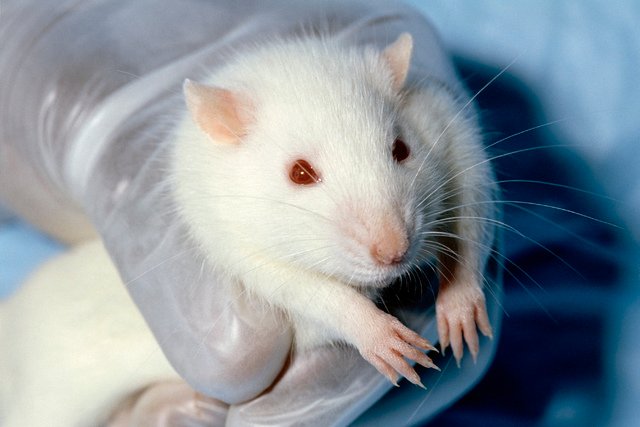
1974
Stanley N. Cohen and Herbert Boyer continue their research and clone the first animal gene by splicing the genes of the African Clawed Frog (Xenopus Laevis) into the an E. Coli bacterium's DNA and subsequently replacing it into the cell where the recombinant DNA was then replicated.
Rudolph Jaenisch created the first transgenic animal by injecting mouse blastocysts with SV40 DNA and then transferring them into the ovaries of female subjects, the resultant offspring were healthy and tested positive for the presence of SV40, they did not however exhibit the ability to transfer the genes to their own offspring. In light of further advancements Berg teamed with National Academy of Sciences president Philip Handler and scientists from MIT to produce " An Open Letter to the Asilomar Conference on Recombinant DNA" a document aimed at the members of the upcoming conference (scheduled for February 1975) which voiced concerns about "the current hazards of introducing manmade microorganisms into the environment" as well as the seemingly inevitable progression towards the application of new techniques to human genetic manipulation and proposed a moratorium on further experiments until more information on the potential results could be formulated. The letter appeared in Science magazine and the voluntary moratorium was observed.
1975
The Asilomar Conference on Recombinant DNA Molecules is held. Organized by Paul Berg, Maxine Singer and Richard Roblin it's chief purpose was to revisit the voluntary moratorium and consider it's removal. The result was that the moratorium was removed and recombinant DNA research could continue under the governance of strict guidelines.
The World Health Organization later issued a press release implying its cooperation with The Advisory Committee on Medical Research which had decided to support research involving the creation of recombinant DNA molecules. The Committee fully acknowledged the risks involved feeling capable of minimizing them.
1976
Robert Swanson enlists Boyer to co-found Genetech the first company dedicated to genetic engineering.
Director of the National Institutes of Health (NIH), Dr. Donald Fredrickson issues a press release of the NIH's Guidelines for Recombinant DNA research.

Genentech's Logomark
1977
Genentech successfully produces somatostatin a human protein inside an E. Coli bacteria.
Lindow utilizes recombinant DNA technology to recreate the mutant P. syringae strain.
1978
Genentech successfully produces human insulin through recombinant DNA technology. Genetech previously began a joint program with City of Hope Medical Center cooperating to further research of recombinant DNA.
1980
Ananda Chakrabarty developed a hybrid strain of Pseudomonas and <Arthrobacter bacteriums capable of dissimilating components that make up crude oil, her request for a patent on the bacteria itself was rejected. The resulting legal battle was ultimately handed up to the U.S. Supreme Court which eventually ruled that organisms which are a result of the ingenuity of man and thus could not occur otherwise in nature are although alive, still a creation of that man's mind and therefore genetically altered life could be patented under 35 U.S.C. § 101.

Chakrabrty et al's U.S. Patent
1982
The FDA approves the commercial sale of Genentech's genetically engineered insulin as Humulin.
Continuing Jaenisch's research Richard Palmiter and Ralph Brinster create the world's first transgenic animal capable of transferring its altered genes in reproduction in a mouse. The promoter of the metallothionein-I gene was fused to a rat growth hormone gene and injected into fertilized mouse eggs. One-third of the developed mice carried the fusions gene, slightly less than one-third grew significantly larger.
1984
Roy Scott Chaleff and Thomas B. Ray publish results detailing successful creation of mutant strains of Nicotiana tabacum (tobacco) resistant to sulfonylurea herbicides. The mutation, which involves production of an altered form of acetolactate synthase (ALS) was found at two distinct, unlinked genetic loci.
1986
The first genetically modified crop field tests occur in the U.S. and France using herbicide-resistant tobacco strains.( the most information I could find here is a Global Review for Transgenic plant Field Testing of years 1986 - 1995, see references.)
AGS receives a $20,000 fine from the EPA for vilating a permit by experimentally injecting their P. syringae strain into trees on a rooftop
1987
Yoshizumi Ishino accidentlally clones a section of prokaryotic DNA section with an E. Coli iap gene, the section contained homologous sequences arranged in direct repeats and were called REP sequences. The fuction of the sequences was unknown however it it was determined they could be used in the stabilization of mRNA.
AGS releases the first genetically engineered organism into the environment with the testing of its product Frostban ®, a frost inhibiting P. syrinage strain on strawberry fields although the test was overturned due to a previous permit violation.
Lindow also conducted frost inhibition field tests of his IceMinus P. syringae strain on potato crops, despite vandalism by radical GMO opposers.
1988
Harvard University is granted a U.S. Patent for a transgenic non-human mammal, specifically a mouse. Harvard scientists previously named such a mouse an Oncomouse in reference to the oncogene which causes tumor growth, the onco prefix itself coming from the Greek Onkos meaning mass or bulk.1989
Data published on transgenic pigs at a Maryland research station reveal a high incidence number of diseases and resultant deaths in some cases.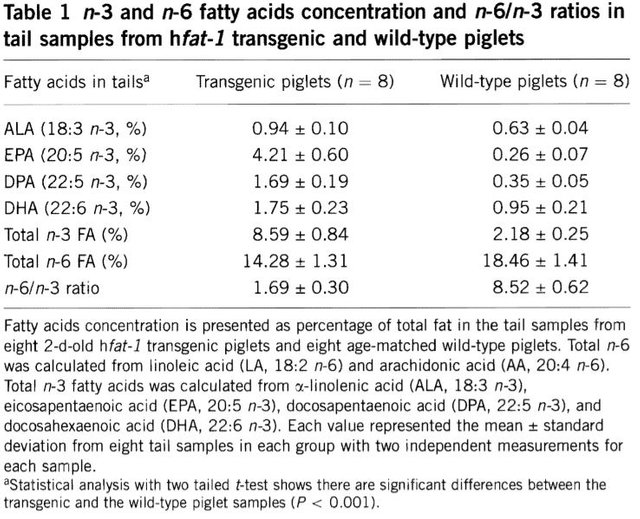
Transgenic Pigs FA Levels
1990
NIH Researchers recruit two unrelated young girls suffering from adenosine deaminase (ADA) deficiency to participate in the first clinical gene therapy trial Patient 1 was initiated in Sept. The procedure involved drawing blood from the patient and inducing T-cell replication, then injecing ADA retroviral vectors into the cultured T-Cells and reinitroduce them to the patient.The Dept. of Energy and the NIH announce a plan for a 15-year project to sequence the human genome.
1991
NIH scientists initiate the trial for Patient 2 in Jan.1992
China becomes the first country to commercialize transgenic plants introducing virus resistant tobacco to the market.1993
The FDA approves the commercial use of Bovine somatotropin (bST) a protein hormone used to increase milk production in dairy cows.1994
Biotech Company Calgene attains approval for commercial release of tomatoes genetically engineered for longer shelf life dubbed Flavr Savr.The European Union approves its first genetically engineered crop, herbicide resistant tobacco.
1995
After being approved by the FDA GM Staple crops receive marketing approval within the U.S. as Potatoes engineered to produce Bacillus thuringiensis, a soil dwelling bacterium found to have insecticidal properties is approved by the EPA becoming the first pesticide producing crop approved for commercial sale in the United States.The results from the first human gene therapy trials (1990,1991) are published showing the patients developing stronger immune systems and white blood cell levels following the therapy.
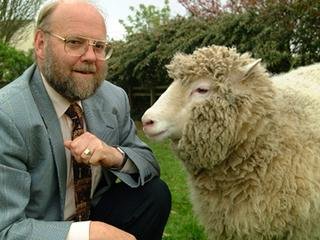
Dr. Ian Wilmut and Dolly
the cloned sheep
1996
Using the nuclear transplantation technique and a cell reprogramming method Dr. Ian Wilmut creates the world's first mammalian clone from a sheep udder cell. The sheep is named Dolly after American singer Dolly Parton.1997
A group of scientists including Wilmut, Angelika Schnieke, Alexander J. Kind, William A. Ritchie, Karen Mycock, Angela R. Scott, Marjorie Ritchie, Alan Colman and Keith H. S. Campbel among others publish successful demonstration of nuclear tranfer of two desired genes: a neomycin reistance marker and human coagulation factor IX into tranfected cells, ( cells previously injected with genetic material) designed to be expressed in the sheep's milk. Six transgenic lambs were born three of which used the transfected cells the other three were created using uncloned cells. The lambs born of transfected cells displayed both genes while the lambs form the uncloned cells displayed only the resistane marker.Regulation (EC) No 258/97 of the European Parliament and of the Council is passed requiring novel foods and novel food ingredients to be submitted to a one time saftety assessment in the interest of public safety. A swedish field test of rapeseed revealed two unatuhorised lines of modified rapeseed, the cause was traced back to German producer <bAgrEvo a seemingly unintentional mixup however the Dept. of Agriculture took it very seriously and the testing company Svalöf Weibull planned to seek damages.
Jacques Cohen and colleagues report a successful human childbirth after transfer of anucleate donor oocyte cytoplasm into human eggs, the offspring has been created with three cytoplasms thus having DNA contributions from three parents.
1998
Delta & Pine Land Co. and the U.S. Department of Agriculture are granted a patent on ‘Terminator technology’, a genetic technique which disables a seed’s ability to germinate, US Patent No. 5,723,765. UK supermarket chain Iceland bans genetically modified ingredients from its brand foods. Charles Secrett, Executive Director of Friends of the Earth remarked: "..... It is outrageous that large multinational companies are changing the fundamental nature of the food we eat simply to make more money....." other supermarket chains in the UK soon follow suit. (Many more significant events took place this year see references.)1999
Jesse Gelsinger an 18 year old suffering from a metabolic disorder called ornithine transcarbamoylase (OTC) agreed to take part in a gene therapy study. He was given a dose of corrective OTC genes using an adapted recombinant cold virus as a vector from which he suffered a severe immune reaction resulting in his death four days later.Many Rapeseed crops in the UK are ‘accidentally’ contaminated by GM rapeseed imported by Advanta Seeds.
2000
Xudong Ye, Salim Al-Babili and others increase the nutrient value of a first time in the creation of recombinant rice strain which produces beta carotene, it becomes known as Golden rice.Researchers of The Human Genome Project sequence 90 percent of the human genome with 4-fold redundancy. This working draft sequence is estimated at 99.9% accuracy.
2001
UK Parliament passes a regulation allowing human embryo cloning for disease research experimentation up to the 14th day of life for the purposes of research into serious diseases.Directive 2001/18/EC Enacted allowing Member States to restrict or prohibit use or sale of GMO products within it's borders if the GMO poses some threat to humans or the environment.
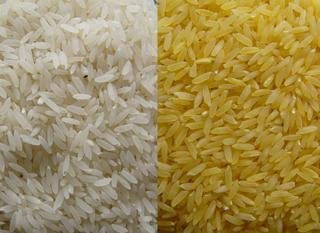
Golden Rice in comparison to regular rice
2002
Biotechnology specific patent laws are proposed to protect scientists intellectual property and promote innovation.2003
The Human Genome Project ends successfully as the entire Human Genome is fully sequenced.European regions band together forming a Network of GMO free regions in defense of agriculture policies. The agreement however carried no legal implications.
2004
The EC passes regulations requiring the labeling of a GMO food products and and later extended to include products which contain ingredients made with GMO's.2005
Golden rice 2 is created, a variety of Golden rice which produces 23 times the carotenoids as the original.2006
A group of scientists including Yifan Di, Liangxue Lai, Jing X Kang, William T Witt and several others publish the results of an experiment to produce transgenic livestock (pigs) which produce high levels of omega 3 fatty acids which are found to be beneficial to humasn health. The insertion of a fat gene found in C. clegans the Roundworm successfully produced transgenic piglets (again half trangenic stock, half uncloned stock) which displayed varying concentrations of fatty acids in samples from different body locations however the results consistently show significant differences in transgenic and natural piglet specimens. (see table 1).2007
Rodolph Barrangou , Christophe Fremaux, Hélène Deveau, Melissa Richards and others publish evidence that Clustered regularly interspaced short palindromic repeats (CRISPR) and nearby cas genes, a feature in bacteria and prokaryotes displays resistance against bacteriophages and when introduced to a virus the bacteria reacted, modifying the phage-resistance phenotype.2008
Brouns and associates discovers the Cas proteins role in CRISPRS viral resistance. The prokaryotes integrate fragments of viral material into CRISPRs each repeat contains a copy of sequences derived from the viral material, a Cas genes place the with CRISPR RNA in the repeats allowing it to inhibit viral replication.2009
11 different Transgenic crops are grown in 25 countries including the U.S., Brazil, Canada and China.2010
The European Union approves German chemical company BASF's genetically modified potato Amflora for industrial applications. The potato has been engineered to produce only amlyopectin and is not fit for human consumption it is grown solely for its starch content.Barrangou and Phillipe Horvath develop the CRISPR/Cas9 system significantly increasing the efficiency of gene editing.
To date there are over 25 applications for genetically altered swine in agriculture and medicine.
2012
Martin Jinek, Krzysztof Chylinski, Ines Fonfara and others further advance understanding of the CRISPR/Cas9 system revealing a subset which demonstrates the capability to make double stranded breaks in targeted DNA as well as increased accuracy of cleavage site selection.2013
Masahito Tachibana, Paula Amato, Michelle Sparman, Nuria Marti Gutierrez and several others publish the successful reprogramming of somatic stem cells using Nuclear Transfer to create stabilized Embryonic Stem Cells (ESC's).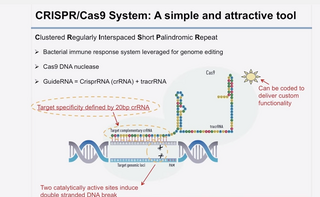
CRISPR/Cas9 slide MIT
2014
Children born of the three parent cytoplasm transfer in 1997 are high school graduate age, scientists begin following up with the genetically modified offspring to determine their health.2015
Chinese scientists Puping Liang, Yanwen Xu, Xiya Zhang, Chenhui Ding and others apply the CRISPR/Cas9 system to modify the human β-globin gene utilizing discarded human tripronuclear zygotes.(low quality human embryo's) in an attempt to rectify a blood disease called beta-thalassaemiaThe UK House of Commons votes to allow in vitro fertilization using three distinct DNA sources.
2017
Oh man don't even get me started on 2017! A groups of professionals from a number of establishments in the U.S. and the UK have put forth a document which in essence calls attention to the unknown scientific and ethical implications of performing Germline engineering resulting in a human pregnancy, they also reason that germline engineering should be performed only with sufficient oversight as well as ethical justification and transparency to the public. In essence this multinational group of scientific institutions is worried that such experiments could result in modified human offspring which have the capability to pass their altered genes on to their progeny which would undoubtedly have significant consequences either immediately and/or in the near future.Chinese scientists have successfully altered beagle DNA creating dogs with twice the muscle mass of normal beagles.
A couple in the UK flew to South Korea to receive to puppies cloned from their dead pet. Commercial modification is on its way.
So we've finally reached end we've stepped off the time machine back into our own now, only now it seems alot more like the future of some science fiction blockbuster. We've witnessed scientific plagiarism, legal battles over trademark infringement, patent disputes (not to mention revision of laws to accommodate living 'intellectual property'), unauthorized experimentation, radical civilian crop destruction , numerous conferences and correspondence detailing concern for potentialities harmful to human or environmental health and now we begin to see genetic modification being used in recreational applications. There are already some 17 actual genetically modified humans in the population currently, true their only difference is having DNA from one extra parent but it is a difference, can they pass it on to their offspring? The important question is are there more instances of illegal experimentation? Although scientists agree that the CRISPR/Cas9 system requires some further refinement it currently allows even scientists new to the field to easily create a modified DNA strand. Genetically modified foods and animals are already commonplace in society it is only a matter of time before mankind agrees that the past to health an longevity is to turn genetic modification onto itself, and this ideas has been around awhile as well, perhaps my next article will be an in depth exploration of the biotechnological facet of The Transhumanist Movement. Thanks everybody for taking the ride feel free to spend hours and hours poring of the scientific publications, abstracts, and science websites provided below like I did. Enjoy!
1. Lederburg/Tatum Bacterial Genetics: https://profiles.nlm.nih.gov/ps/retrieve/Narrative/BB/p-nid/30
2. Nirenberg/Matthaei synthetic RNA: https://oculus.nlm.nih.gov/cgi/f/findaid/findaid-idx?c=nlmfindaid;id=navbarbrowselink;cginame=findaid-idx;cc=nlmfindaid;view=reslist;subview=standard;didno=nirenberg566;focusrgn=bioghist;byte=10893019
4.Berg recombinant DNA: https://profiles.nlm.nih.gov/ps/access/CDBBKH.pdf
Potential Hazards of Recombinant DNA Molecules: http://science.sciencemag.org/content/185/4148/303
5. Cohen/Boyer First Animal Gene Cloning: https://www.ncbi.nlm.nih.gov/pmc/articles/PMC388315/?page=1
6.Jaenisch First Transgenic Animal: https://www.ncbi.nlm.nih.gov/pmc/articles/PMC388203/?page=1
7.Asilomar Conference: https://profiles.nlm.nih.gov/ps/access/DJBBSB.pdf
Report to the Organizing Committee of The Asilomar Conference on Recombinant DNA: https://profiles.nlm.nih.gov/ps/access/DJBBJZ.pdf#xml=https://profiles.nlm.nih.gov:443/pdfhighlight?uid=DJBBJZ&query=%28asilomar%20conference%29
8. Genentech, First Biotech company: https://www.gene.com/media/press-releases/4160/1978-09-06/first-successful-laboratory-production-o
9. Diamond v. Chakrabrty: https://supreme.justia.com/cases/federal/us/447/303/case.html
10. Humulin, First recombinant DNA product approved by FDA: https://www.gene.com/media/press-releases/4193/1982-10-29/first-recombinant-dna-product-approved-b
11. Palmiter/Brinster First transgenic animal with transferrable DNA: http://pubmedcentralcanada.ca/pmcc/articles/PMC4881848/
12. Chaleff/Ray Herbicide resistant tobacco: https://link.springer.com/article/10.1007/BF00337755?no-access=true
13. Global Review for Transgenic plant Field Testing of years 1986 - 1995: https://www.isaaa.org/resources/publications/briefs/01/download/isaaa-brief-01-1996.pdf
14. Yoshizumi Ishino Iap genes: http://jb.asm.org/content/169/12/5429.long
15. Frostban, First genetically engineered organism released into the environment: http://articles.latimes.com/1987-05-03/business/fi-8721_1_biotech-companies/2
16. Lindow research: http://plantandmicrobiology.berkeley.edu/profile/lindow#a1
17. Harvard University Oncomouse patent: http://patft.uspto.gov/netacgi/nph-Parser?Sect2=PTO1&Sect2=HITOFF&p=1&u=/netahtml/PTO/search-bool.html&r=1&f=G&l=50&d=PALL&RefSrch=yes&Query=PN/4736866
Origins of oncomice: http://genesdev.cshlp.org/content/21/18/2258.full?sid=a9ef2d89-9220-4bb6-b416-10ba6e13a1df
18. Transgenic pigs and pathological diseases: https://www.nap.edu/read/10418/chapter/8#98
Engineered livestock (bGH): https://www.ncbi.nlm.nih.gov/pubmed/2499927
19. First Human Gene Therapy: https://www.genome.gov/10000521/
20. The Human Genome Project: https://www.genome.gov/25520329/
21. China commercializes first transgenic plant: https://www.isaaa.org/resources/publications/briefs/05/download/isaaa-brief-05-1997.pdf
22. <i>Bovine somatotropin</i> approved for commercial use in the US: http://www.sciencedirect.com/science/article/pii/S0739724099000284
23. Flavr Savr Tomatoes: http://ucanr.edu/repository/cao/landingpage.cfm?article=ca.v054n04p6&fulltext=yes
24. European Union approves First transgenic crop, herbicide resistant tobacco: https://www.newscientist.com/article/mg14219301.100-transgenic-tobacco-is-european-first/
25. Bt Potatoes: https://msu.edu/~douchesd/papers/Grafius%20Douches%20Present%20and%20Future%20Role%20195-221.pdf
26. First Human Gene Therapy Results revealed: https://www.genome.gov/10000521/
27. Dolly First Mammalian Clone: https://academic.microsoft.com/#/detail/1970894097
28. Lambs cloned using transfected cells: https://academic.microsoft.com/#/detail/2075679174?FORM=DACADP
29. European Union concerning novel foods and novel food ingredients: http://eur-lex.europa.eu/legal-content/EN/TXT/PDF/?uri=CELEX:31997R0258&from=EN
30. Human offspring from three cytoplasms: http://www.thelancet.com/pdfs/journals/lancet/PIIS0140-6736(05)63306-5.pdf
31. Terminator Technology: http://www.home.intekom.com/tm_info/rw80405.htm#USA
UK Supermarket GMO Ban: http://www.home.intekom.com/tm_info/rw80405.htm#GE -
GMO Food News 1998: http://www.home.intekom.com/tm_info/rw80405.htm#
32. First gene therapy trial death: https://www.ncbi.nlm.nih.gov/pmc/articles/PMC81135/
33. Rapeseed crop contamination:
34. Golden Rice: http://www.goldenrice.org/PDFs/Ye_et_al_Science_2000.pdf
35. Human Genome Project 90% sequenced: https://www.genome.gov/10001457/
36. Parliament allows human embryo cloning up to 14 days of life: file:///C:/Users/Gerald/Downloads/Human%20embryo-escPIIS1472648310622286.pdf
37. Biotechnology intellectual patent laws: http://www.nzlii.org/nz/journals/CanterLawRw/2002/5.html#Heading26
38. Human Genome Fully sequenced: https://www.genome.gov/11006943/human-genome-project-completion-frequently-asked-questions/
39. European Network of GMO free regions: http://gmo-free-regions-nrw.de/Portals/0/NetworkPRESS-solidarity_to_Oberosterreich_Oct05.pdf
40. EC GMO lableing regulations: https://ec.europa.eu/food/plant/gmo/legislation_en
41. Golden Rice 2: http://www.goldenrice.org/PDFs/USDA_GR2_2010.pdf
42.Transgenic Pigs rich in fatty acids: http://d-scholarship.pitt.edu/5611/1/31735062121359.pdf
43. Barrangou Clustered regularly interspaced short palindromic repeats: http://web2.uconn.edu/gage/MCB3617/barrangou_science_2007.pdf
44. Brouns Cas proteins: https://www.ncbi.nlm.nih.gov/pubmed/18703739/
45. Global Transgenic Crops: http://www.isaaa.org/resources/publications/briefs/43/executivesummary/default.asp
46. Amflora Potatoe: http://www.nytimes.com/2010/06/11/world/europe/11sweden.html
47. CRISPR/Cas9: http://www.micab.umn.edu/courses/8002/Horvath.pdf
48. Transgenic pigs in agriculture and medicine: http://onlinelibrary.wiley.com/doi/10.1002/mrd.21333/full
http://adsbm.msu.edu/uploads/files/Prather_BGER.pdf
49. CRISPR/Cas9 double strand cleavage: https://www.ncbi.nlm.nih.gov/pubmed/22745249
50. Nuclear Transfer and Stem Cells: http://www.cell.com/cell/pdf/S0092-8674(13)00571-0.pdf
51. Three cytoplasm human clones of high school graduation age: https://techcrunch.com/2014/09/28/the-worlds-first-genetically-modified-babies-will-graduate-high-school-this-year/?ncid=txtlnkusaolp00000591
52. CRISPR/Cas9 and Human Embryos: https://www.ncbi.nlm.nih.gov/pmc/articles/PMC4417674/
53. House of Commons allows three DNA human cloning: http://www.cnn.com/2015/02/03/health/uk-ivf-3-person-babies/index.html
54: Human Germline Genome Editing Document: https://www.ncbi.nlm.nih.gov/pubmed/28777929
55. Chinese scientists create hyper muscular dogs: http://www.express.co.uk/news/world/828981/China-genetic-engineering-super-soldiers-dogs
56. South Korean scientists clone dead pet: https://www.theguardian.com/science/2015/dec/23/uk-couple-await-birth-of-two-clones-of-dead-dog
</html>
Very long, exhaustive, and informative post...strained my eyes reading through most of that (more pictures would have been nice XD), but still worth it.
Knew a lot of this stuff, but didn't think there was as much to each element of the grander story these events portray as there is.
Not bad. Good post :D
Keep em' coming man :)
Happy Steeming =D
Thanks! yea its a timeline and not a traditional article so not for just reading through in one sitting, I was actually trying NOT to make it to image heavy LOL and yea most gmo info is already on wikipedia so I took the time to further research it and find the scientific publications for those interested in the actual science behind it all (found in the references). I greatly appreciate your input!
:)
Yeah, I figured :P
I noticed, but I still think there could be enough to stop eye strain from occurring, cause constantly reading text, especially for those with a white version of Steemit, can prove quite visually strenuous.
That is pretty good, that you did that. Most people just lift the text/documents directly and upload it, and expect it to be appreciated, so its pretty cool that you took a subject already covered by people far smarter and more informed than you and I and presented in a format you thought could be informative and easily digested too.
You're very welcome :)
Wouldn't have found these posts if you hadn't mentioned them in your comment on my post XD
Congratulations @sevenstonesgfx! You have completed some achievement on Steemit and have been rewarded with new badge(s) :
Click on any badge to view your own Board of Honor on SteemitBoard.
For more information about SteemitBoard, click here
If you no longer want to receive notifications, reply to this comment with the word
STOPHi, I've upvoted you, here are some related posts I found:
I'm the AskSteem Bot [BETA] - I try to be helpful but if you don't want me click my username and hit "mute". You can also leave feedback.
It stands to the everlasting credit of science that by acting on the human mind it has overcome man's insecurity before himself and before nature.
- Albert Einstein